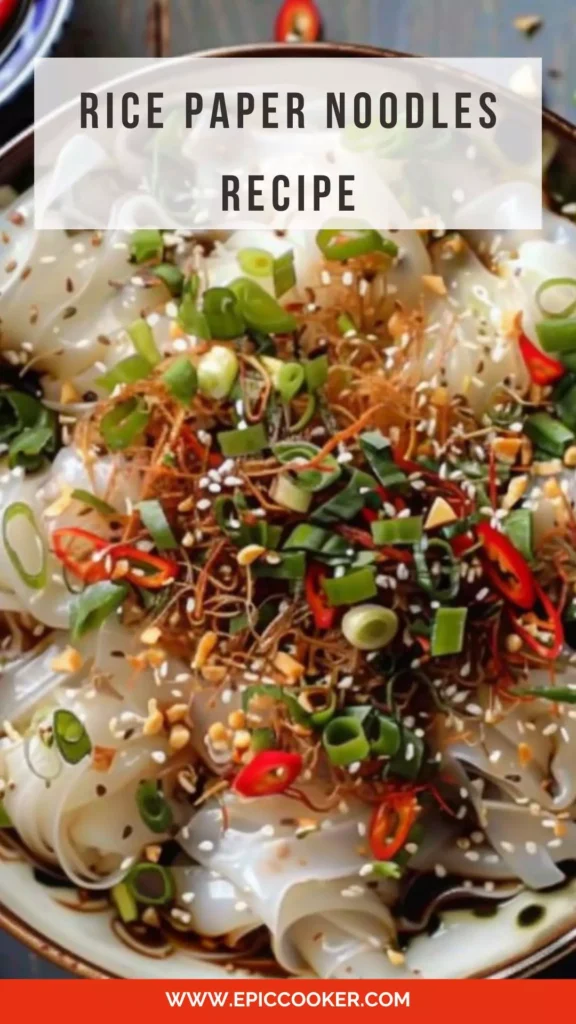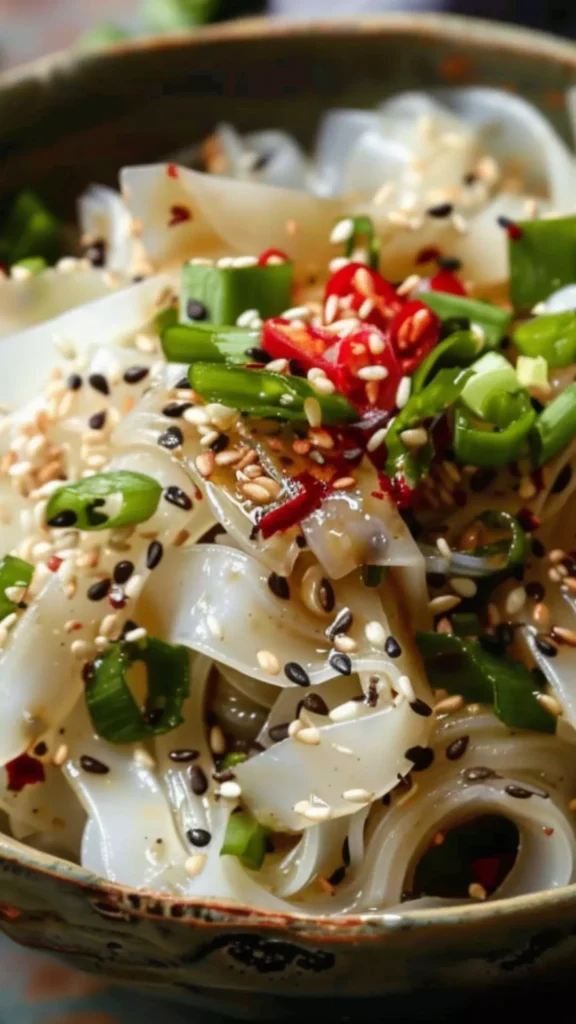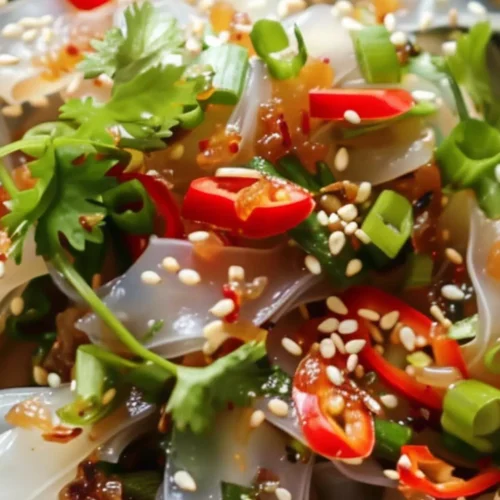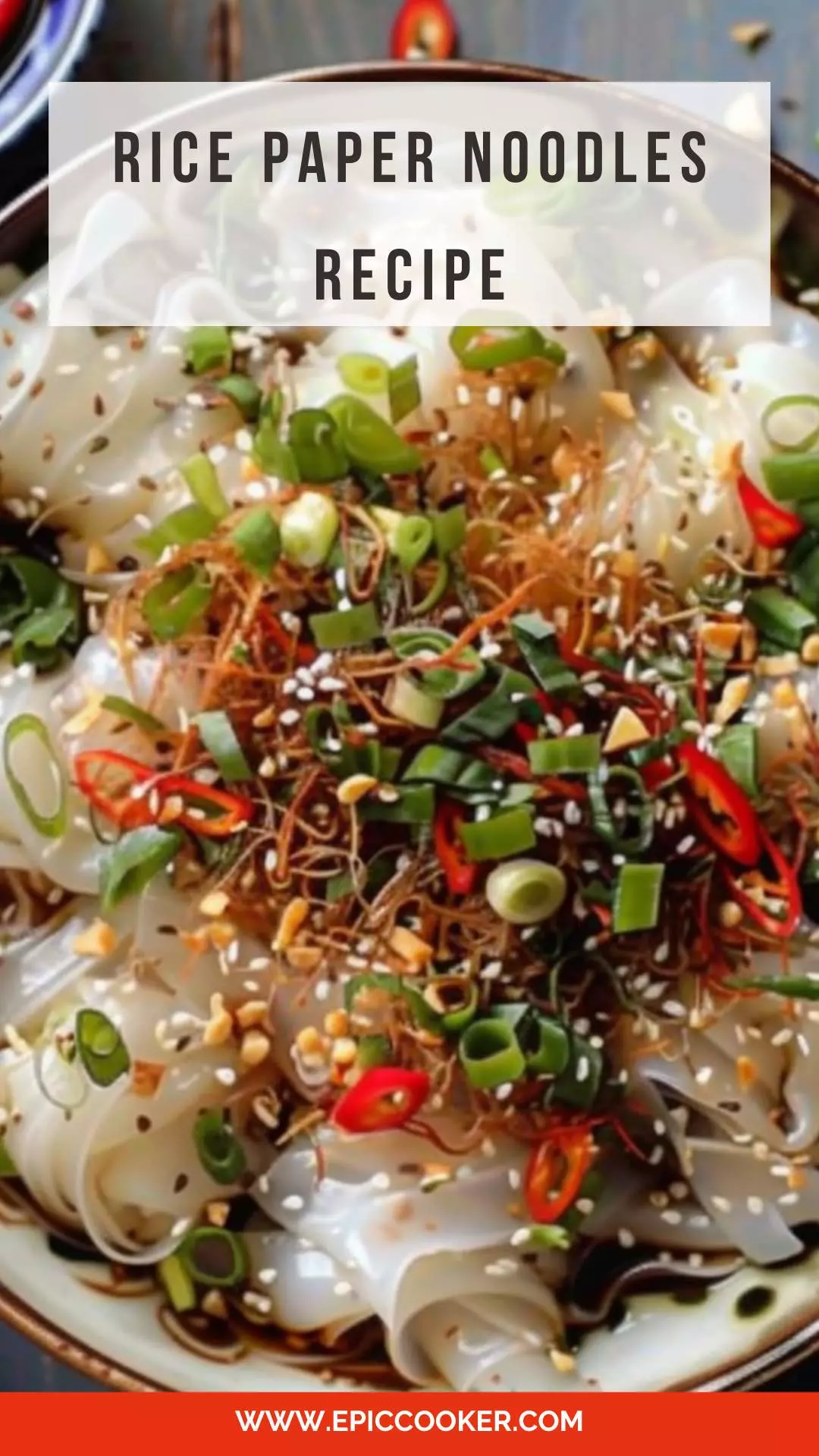As a culinary enthusiast, I enjoy immersing myself in various cuisines from around the globe. Today, I’m thrilled to share with you an enticing and flavorsome recipe for rice paper noodles. Transport your taste buds to the vibrant streets of Asia as we delve into the magical realm of this delectable dish.
Join me on this culinary adventure as we explore why this recipe works, the required ingredients, step-by-step instructions, tips for enhancing the flavors, storage advice, nutritional information, serving suggestions, ingredient substitutes, frequently asked questions, and of course, a mouthwatering conclusion.

What is Rice Paper Noodles Recipe?
Rice paper noodles, also known as rice vermicelli, are thin, translucent noodles made from rice flour. These delicate strings of goodness are a staple in many Asian cuisines, including Vietnamese, Thai, and Chinese.
Rice paper noodles are incredibly versatile and can be used in various dishes, such as spring rolls, soups, salads, and stir-fries. Their light and chewy texture, coupled with their ability to absorb flavors, make them a perfect canvas for a myriad of culinary creations.
Why This Recipe Works:
The beauty of this rice paper noodle recipe lies in its simplicity and adaptability. It strikes the perfect balance between fresh and zesty flavors, making it an ideal dish for warm summer days or any time you crave a light yet satisfying meal.
The combination of the tangy sauce, crisp vegetables, and tender noodles creates a delightful harmony of tastes and textures. Additionally, this recipe allows for personalization, enabling you to add your favorite ingredients to enhance the overall experience.
What You’ll Need to Make This Dish:
To embark on this flavorful journey, ensure you have the following ingredients at your disposal:
Sauce:
- Coconut Aminos: Used as a substitute for soy sauce, coconut aminos add a salty and slightly sweet flavor to the sauce while keeping the dish gluten-free and soy-free.
- Rice Vinegar: Provides acidity and tanginess to the sauce, balancing the flavors and adding brightness.
- Aged Balsamic Vinegar: Adds depth, complexity, and a subtle sweetness to the sauce, enhancing its overall flavor profile.
- Grated Garlic Clove: Contributes aromatic flavor and depth to the sauce, infusing it with a rich garlic essence.
Rice Paper Noodles:
- Avocado Oil or Light Olive Oil: Used to coat the rice paper noodles and prevent them from sticking together, as well as adding a subtle flavor.
- Rice Paper: Provides the base for the noodles, offering a gluten-free and light alternative to traditional wheat-based noodles.
- Chopped Scallion: Adds freshness, color, and a mild onion flavor to the noodles, enhancing their overall taste and appearance.
- Toasted Sesame Oil: Adds nutty flavor and aroma to the noodles, enhancing their richness and depth of flavor.
- Toasted White Sesame Seeds: Contribute a nutty and crunchy texture to the noodles, as well as adding visual appeal and a subtle flavor.
- Thai Red Chili Pepper or Gochugaru flakes: Adds heat and spice to the noodles, balancing the flavors of the dish and providing a kick of flavor.

How to Make Rice Paper Noodles?
Now that we are well acquainted with the ingredients, let’s dive into the step-by-step process of creating this delicious dish. Get your apron on, and let’s begin:
Step 1: Prepare the Sauce:
In a small bowl, combine the coconut aminos, rice vinegar, aged balsamic vinegar, and grated garlic. Stir well to incorporate all the flavors. Set aside until needed.
Step 2: Soften the Rice Paper:
Fill a large shallow bowl or pie dish with warm water. Take one rice paper sheet and immerse it in the water for a few seconds, allowing it to soften. Once pliable, remove it from the water and place it on a clean surface, such as a cutting board or countertop.
Step 3: Layer the Ingredients:
Spread a thin drizzle of avocado oil or light olive oil onto the softened rice paper sheet, ensuring it covers the entire surface. Next, layer the chopped scallion, toasted sesame oil, sesame seeds, and Thai red chili pepper slices or gochugaru flakes on top of the rice paper. Feel free to get creative and add any other desired ingredients such as sliced cucumbers, carrots, or fresh herbs.
Step 4: Roll it Up:
Gently roll the rice paper sheet, tucking in the sides as you go. The oil will help seal the edges, ensuring the roll stays intact. Repeat this process with the remaining rice paper sheets and fillings.
Step 5: Ready to Serve:
Once all the rolls are prepared, you can serve them as is or slice them diagonally for a visually appealing presentation. Arrange the rolls on a serving platter and pour the sauce into a dipping bowl or drizzle it over the rolls. Garnish with additional sesame seeds, sliced scallions, or fresh herbs for added freshness. Serve immediately and enjoy!
Tips for Enhancing the Flavors:
1. Soaking the rice paper sheets in warm water for the perfect softness.
2. Adding a touch of oil prevents the rice paper from sticking and aids in rolling.
3. Be mindful not to overstuff the rolls, as it may lead to tearing.
4. Experiment with various fillings and herbs to create your own unique flavor combinations.
5. To elevate the taste, try marinating proteins such as shrimp or tofu before adding them to the rolls.
How to Store Leftovers?
In the unlikely event that you have any leftovers, the rice paper rolls can be stored in an airtight container in the refrigerator for up to two days. However, it is worth noting that their freshness and texture are best experienced when consumed immediately after preparation. To retain their crispness, avoid soaking them in water or refrigerating them for an extended period.

Nutrition Information:
Here’s a breakdown of the approximate nutritional values for this recipe:
– Calories: 180 per serving (based on six rolls)
– Fat: 8g
– Carbohydrates: 22g
– Protein: 3g
– Fiber: 2g
– Sugar: 1g
How Would I Recommend Serving Rice Paper Noodles Recipe?
1. As a Light Lunch Option: Enjoy these delicate rice paper rolls as a refreshing and wholesome midday meal. They make for a perfect break from heavier lunchtime fare.
2. Party Platter: Impress your guests by serving an array of vibrant rice paper rolls at gatherings or potluck events. Arrange them on a platter with various dipping sauces for a visually stunning and interactive experience.
3. Picnic Perfection: Pack these rolls alongside some fresh fruit and a chilled beverage for a delightful picnic. The compact nature of the rolls makes them easily transportable and mess-free.
4. Appetizer Extravaganza: Whether entertaining friends or simply indulging in a cozy night at home, these rice paper rolls are a fantastic choice for an appetizer spread. Serve them alongside other finger foods to create a memorable dining experience.
What Alternatives Can You Use for the Ingredients if Not Available?
Should you find yourself missing a few key ingredients, fear not! Here are some substitutes that can be used in a pinch:
1. Coconut Aminos: Soy sauce or tamari sauce can be substituted for coconut aminos. However, adjust the quantity based on personal preference, as soy sauce tends to be slightly saltier.
2. Rice Vinegar: For a tangy alternative, apple cider vinegar or white wine vinegar can be used instead.
3. Aged Balsamic Vinegar: Try red wine vinegar or white balsamic vinegar as a suitable alternative.
4. Thai Red Chili Pepper or Gochugaru Flakes: If you prefer a milder flavor, replace these ingredients with a pinch of cayenne pepper or omit them altogether.

Rice Paper Noodles Recipe
Equipment
- Large pot for boiling water
- Colander or strainer
- Large mixing bowl
- Cutting board
- Knife
Ingredients
- 1 tbsp Coconut Aminos
- 1 tsp Rice Vinegar
- 1/10 oz Grated Garlic Clove equivalent to 2 small cloves
- 1 tsp Aged Balsamic Vinegar
- 1 Whole Thai Red Chili Pepper sliced, or 2 small pinches of Gochugaru flakes for some heat.
- Sprinkle of Toasted White Sesame Seeds
- 6 sheets of 8.5-inch diameter 21.5cm round-shaped Rice Paper, divided
- 1 tsp Toasted Sesame Oil
- 1 Bulb of Chopped Scallion
- Drizzle of Avocado Oil or Light Olive Oil
Instructions
- In a small bowl, combine the coconut aminos, rice vinegar, aged balsamic vinegar, and grated garlic. Stir well to incorporate all the flavors. Set aside until needed.
- Fill a large shallow bowl or pie dish with warm water. Take one rice paper sheet and immerse it in the water for a few seconds, allowing it to soften. Once pliable, remove it from the water and place it on a clean surface, such as a cutting board or countertop.
- Spread a thin drizzle of avocado oil or light olive oil onto the softened rice paper sheet, ensuring it covers the entire surface. Next, layer the chopped scallion, toasted sesame oil, sesame seeds, and Thai red chili pepper slices or gochugaru flakes on top of the rice paper. Feel free to get creative and add any other desired ingredients such as sliced cucumbers, carrots, or fresh herbs.
- Gently roll the rice paper sheet, tucking in the sides as you go. The oil will help seal the edges, ensuring the roll stays intact. Repeat this process with the remaining rice paper sheets and fillings.
- Once all the rolls are prepared, you can serve them as is or slice them diagonally for a visually appealing presentation. Arrange the rolls on a serving platter and pour the sauce into a dipping bowl or drizzle it over the rolls. Garnish with additional sesame seeds, sliced scallions, or fresh herbs for added freshness. Serve immediately and enjoy!
Notes
- Soaking the rice paper sheets in warm water for the perfect softness.
- Adding a touch of oil prevents the rice paper from sticking and aids in rolling.
- Be mindful not to overstuff the rolls, as it may lead to tearing.
- Experiment with various fillings and herbs to create your own unique flavor combinations.
- To elevate the taste, try marinating proteins such as shrimp or tofu before adding them to the rolls.
Nutrition
Frequently Asked Questions:
Q1. Can I make these rolls ahead of time?
It is best to consume the rice paper rolls immediately after preparation to enjoy their optimal freshness. While you can make them a few hours in advance and refrigerate them, they may become slightly soggy. If prepping ahead, store the sauce separately and drizzle it just before serving.
Q2. Can I make this recipe gluten-free?
Absolutely! Rice paper noodles are naturally gluten-free. Ensure the sauces and condiments you use are also gluten-free to adhere to a gluten-free diet.
Q3. Can I substitute the rice paper sheets with another type of wrapper?
If rice paper sheets are unavailable, you can substitute them with lettuce leaves or soy-based paper wraps for a similar result. Keep in mind that the taste and texture may vary.
Q4. Can I store the rice paper rolls in the freezer?
Freezing rice paper rolls is not recommended, as it may affect the texture and crispness of the rolls. Freshly prepared rice paper rolls are highly recommended for the best taste and texture.
Q5. Can I use a different type of oil for drizzling?
Yes, feel free to use light olive oil or another neutral-tasting oil of your choice if avocado oil is not available.
Q6. Can I adjust the spice level of the rolls?
Certainly! The amount of Thai red chili pepper or gochugaru flakes can be adjusted according to your desired level of spiciness. Add more for an extra kick or reduce the quantity for a milder flavor.
Conclusion:
Embarking on a culinary journey to discover the wonders of rice paper noodles has been both enlightening and satisfying. From the aromatic mix of flavors in the sauce to the delicate texture of the noodles, this recipe has charmed my palate and left me craving for more.
By following the step-by-step instructions and incorporating tips to enhance the taste, you can create a stunning plate of rice paper noodles that will impress both your family and friends.
So, roll up your sleeves, gather the ingredients, and embark on this culinary adventure to experience the magic of rice paper noodles!





